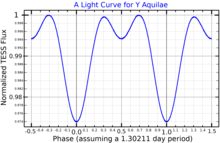18 Aquilae
| Observation data Epoch J2000 Equinox J2000 | |
|---|---|
| Constellation | Aquila |
| Right ascension | 19h 06m 58.60289s[1] |
| Declination | +11° 04′ 16.4173″[1] |
| Apparent magnitude (V) | 5.072 |
| Characteristics | |
| Spectral type | B8 III[2] |
| U−B color index | −0.44[3] |
| B−V color index | −0.08[3] |
| Variable type | Eclipsing[4] |
| Astrometry | |
| Radial velocity (Rv) | −18.6[5] km/s |
| Proper motion ( | RA: −0.89[1] mas/yr Dec.: −32.11[1] mas/yr |
| Parallax ( | 6.43 ± 0.79 mas[1] |
| Distance | approx. 510 ly (approx. 160 pc) |
| Orbit[6] | |
| Primary | A |
| Companion | B |
| Period (P) | 205.16 yr |
| Semi-major axis (a) | 0.399″ |
| Eccentricity (e) | 0.23 |
| Inclination (i) | 134.3° |
| Orbit[6] | |
| Primary | Aa |
| Companion | Ab |
| Period (P) | 1.3023 d |
| Semi-amplitude (K1) (primary) | 27.6 km/s |
| Details | |
| Aa | |
| Mass | 5.6[6] M☉ |
| Luminosity | 4,875[7] L☉ |
| Rotational velocity (v sin i) | 50[2] km/s |
| Ab | |
| Mass | 0.38[6] M☉ |
| Luminosity | 12.7[7] L☉ |
| B | |
| Mass | 3.49[6] M☉ |
| Other designations | |
| Database references | |
| SIMBAD | data |
18 Aquilae (abbreviated 18 Aql) is a triple star[9] system in the constellation of Aquila. 18 Aquilae is the Flamsteed designation; it also bears the variable star designation Y Aquilae. It has an apparent visual magnitude of 5.07. The distance to this system can be estimated from the annual parallax shift of 6.43 mas, yielding a value of around 510 light-years (160 parsecs) away from Earth.

The inner pair of stars in this system form a spectroscopic binary with a combined magnitude of 5.44 and an orbital period of 1.302 days. The primary component is a giant star with a stellar classification of B8 III.[2] Because the orbital plane is inclined near the line of sight, two form an eclipsing binary system. The eclipse of the primary component causes a 0.04 drop in magnitude, while the eclipse of the secondary results in a decrease of 0.03.[11] At an angular separation of 0.310 arcseconds is the magnitude 6.39 tertiary component.[9] This system has a high peculiar velocity of 29.7 ± 3.9 km/s relative to the neighboring stars.[12]
References
- ^ a b c d e van Leeuwen, F. (November 2007). "Validation of the new Hipparcos reduction". Astronomy and Astrophysics. 474 (2): 653–664. arXiv:0708.1752. Bibcode:2007A&A...474..653V. doi:10.1051/0004-6361:20078357. S2CID 18759600.
- ^ a b c Levato, H. (January 1975). "Rotational velocities and spectral types for a sample of binary systems". Astronomy and Astrophysics Supplement Series. 19: 91–99. Bibcode:1975A&AS...19...91L.
- ^ a b Osawa, K.; Hata, S. (1962). "Three-color photometry of B8-A2 stars (II)". Annals of the Tokyo Astronomical Observatory. 7: 209. Bibcode:1962AnTok...7..209O.
- ^ Samus, N. N.; Durlevich, O. V.; et al. (2009). "VizieR Online Data Catalog: General Catalogue of Variable Stars (Samus+ 2007-2013)". VizieR On-line Data Catalog: B/GCVS. Originally Published in: 2009yCat....102025S. 1. Bibcode:2009yCat....102025S.
- ^ Wilson, Ralph Elmer (1953). "General catalogue of stellar radial velocities". Carnegie Institute Washington D.C. Publication. Carnegie Institution of Washington. Bibcode:1953GCRV..C......0W.
- ^ a b c d e Tokovinin, Andrei (2018-03-01). "The Updated Multiple Star Catalog". The Astrophysical Journal Supplement Series. 235 (1): 6. arXiv:1712.04750. Bibcode:2018ApJS..235....6T. doi:10.3847/1538-4365/aaa1a5. ISSN 0067-0049. S2CID 119047709.
{{cite journal}}: CS1 maint: unflagged free DOI (link) - ^ a b De Greve, J. P.; Vanbeveren, D. (1980). "Close Binary Systems Before and after Mass Transfer - a Comparison of Observations and Theory". Astrophysics and Space Science. 68 (2): 433. Bibcode:1980Ap&SS..68..433D. doi:10.1007/BF00639709. S2CID 123281741.
- ^ "18 Aql". SIMBAD. Centre de données astronomiques de Strasbourg. Retrieved 2012-07-25.
- ^ a b Eggleton, P. P.; Tokovinin, A. A. (September 2008). "A catalogue of multiplicity among bright stellar systems". Monthly Notices of the Royal Astronomical Society. 389 (2): 869–879. arXiv:0806.2878. Bibcode:2008MNRAS.389..869E. doi:10.1111/j.1365-2966.2008.13596.x. S2CID 14878976.
{{cite journal}}: CS1 maint: unflagged free DOI (link) - ^ "MAST: Barbara A. Mikulski Archive for Space Telescopes". Space Telescope Science Institute. Retrieved 8 December 2021.
- ^ Malkov, O. Yu.; et al. (February 2006). "A catalogue of eclipsing variables". Astronomy and Astrophysics. 446 (2): 785–789. Bibcode:2006A&A...446..785M. doi:10.1051/0004-6361:20053137.
- ^ Tetzlaff, N.; Neuhäuser, R.; Hohle, M. M. (January 2011). "A catalogue of young runaway Hipparcos stars within 3 kpc from the Sun". Monthly Notices of the Royal Astronomical Society. 410 (1): 190–200. arXiv:1007.4883. Bibcode:2011MNRAS.410..190T. doi:10.1111/j.1365-2966.2010.17434.x. S2CID 118629873.
{{cite journal}}: CS1 maint: unflagged free DOI (link)

